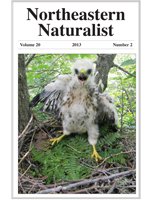Management strategies for Odocoileus virginianus (White-tailed Deer) often use changes in body weight as an indicator of population health and density. Annual fluctuations in White-tailed Deer age-sex classes are influenced by numerous environmental variables. We analyzed 1989–2009 deer harvest data from Virginia's Deer Management Assistance Program (DMAP), consisting of 15,622 deer in the Northern Piedmont of Virginia. We used Pearson's correlation and t-tests to examine impacts of annual fluctuations in precipitation, days with snow accumulation ≥1 inch, temperature, and acorn mast on average weights (kg) of current-year, 1-year-lag, and 2-year-lag fawn, and yearling age-sex classes. Of the variables we examined, seasonal precipitation appears to be the most significant environmental factor influencing White-tailed Deer body weight in the Northern Piedmont of Virginia. When using deer weight fluctuations as an indicator in management plans, managers should consider the influence of seasonal precipitation specific to their geographic region or management unit. Managers in the Northern Piedmont of Virginia should continue to use changes in average deer weights as an indicator of population density and habitat quality due to the stability of weights in response to regional environmental stochastic events.
How to translate text using browser tools
1 July 2013
Influences of Precipitation, Temperature, and Acorn Mast on White-Tailed Deer Body Weight in the Northern Piedmont of Virginia
Sean A.B. Campbell,
Thomas C. Wood
ACCESS THE FULL ARTICLE

Northeastern Naturalist
Vol. 20 • No. 3
September 2013
Vol. 20 • No. 3
September 2013




